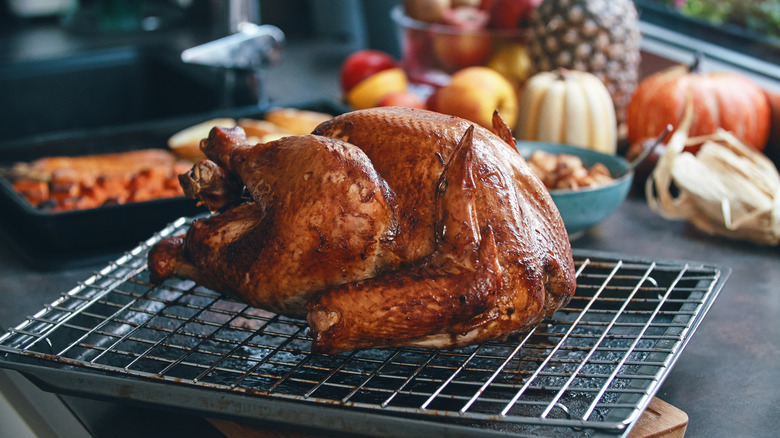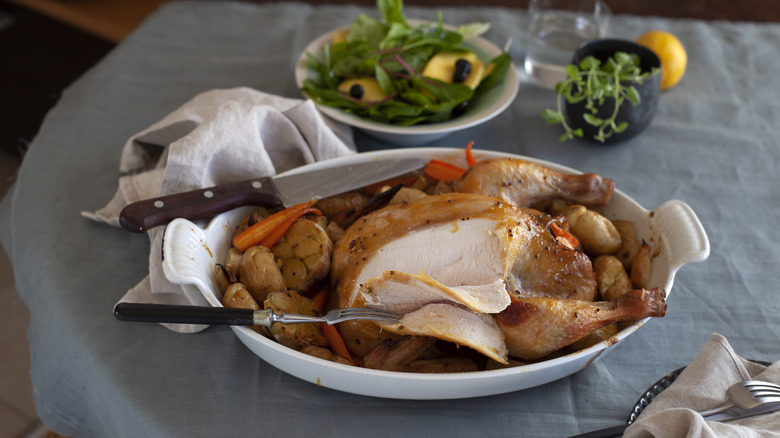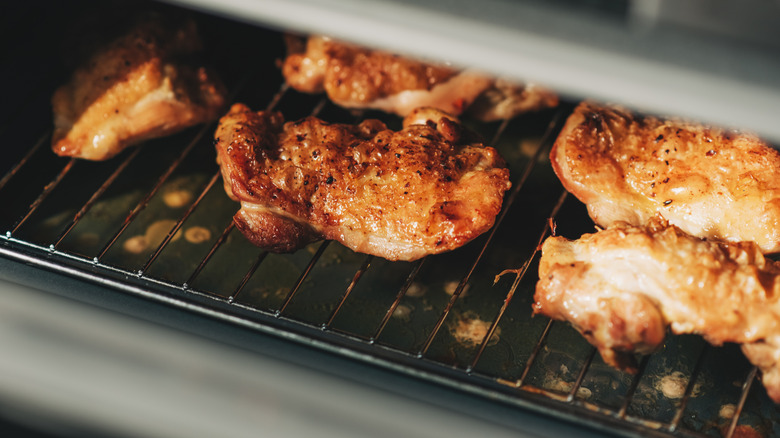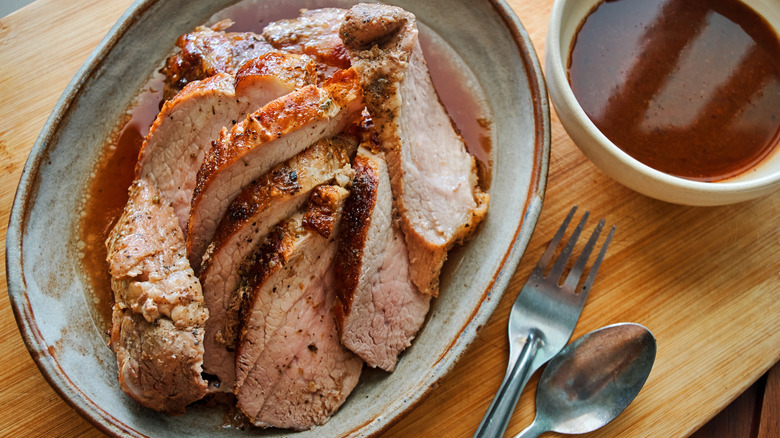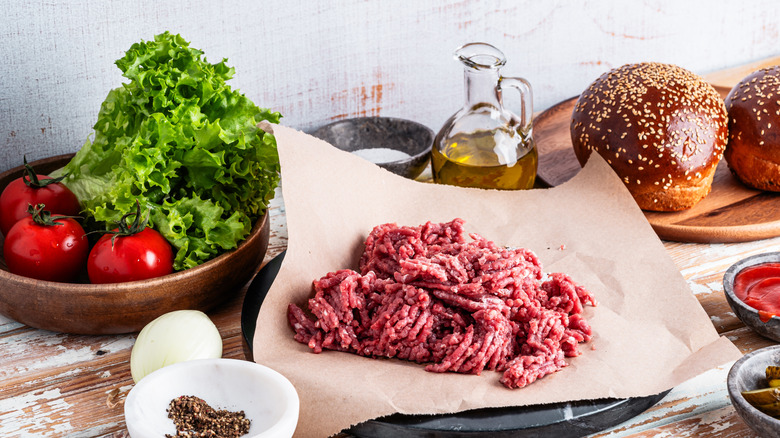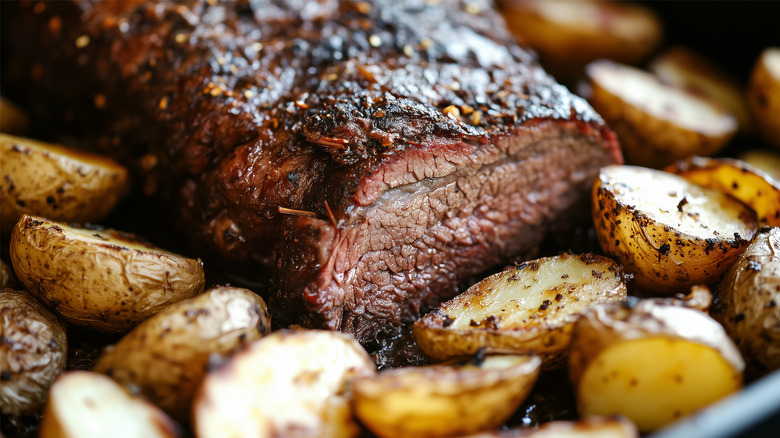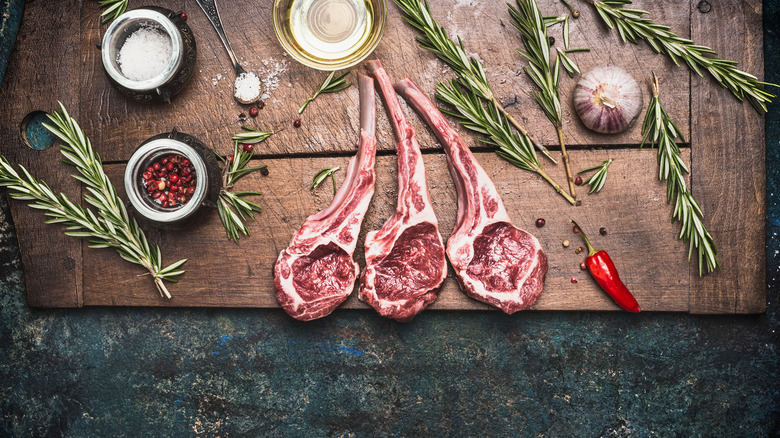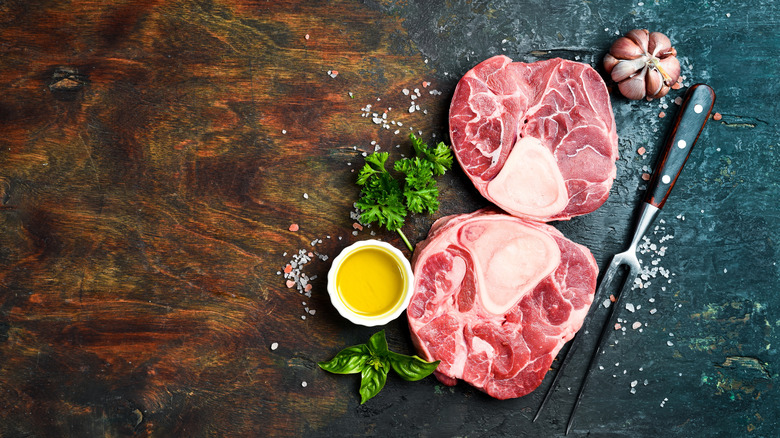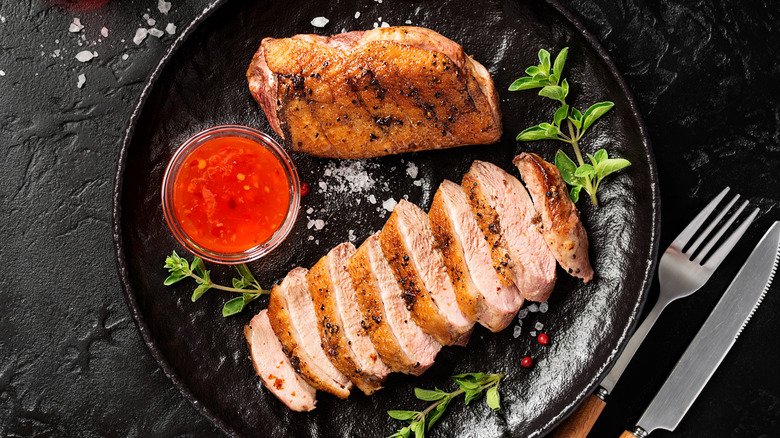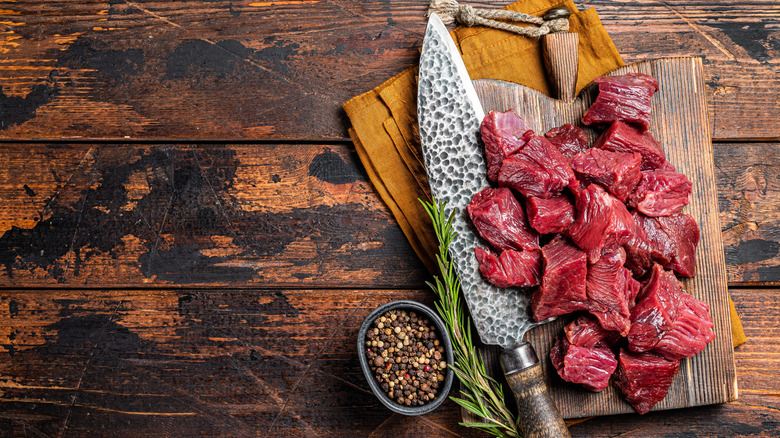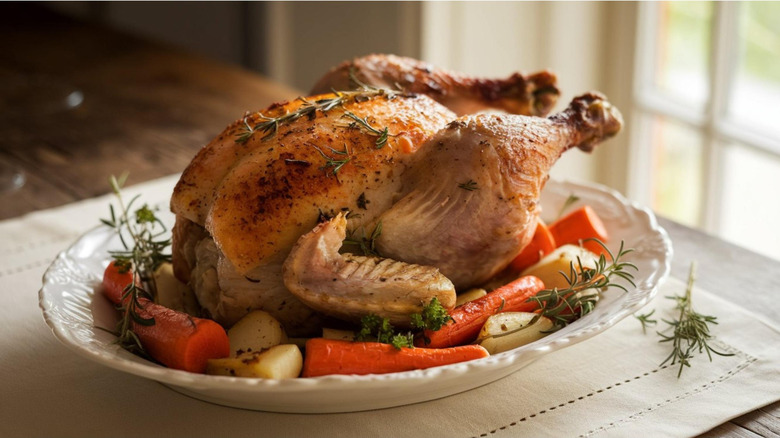The Best Temperature Range For Baking Your Favorite Meats
While grilling or pan-searing is an appealing way to prepare meat, there's often an easier method: baking. Choosing to cook your favorite proteins in the oven allows you to not only multi-task more easily, but also deliver a consistent, delicious, and evenly cooked piece of meat every time. Not all proteins, however, require the same approach — what works for chicken breast won't work for duck, and what works for duck won't work for steak.
But not to worry. We spoke with experts to get their input on the best temperatures to use when baking a variety of meats to ensure you get a beautifully roasted result, every time. Read on to discover the our top temperature recommendations for some of the most popular meats from Lil' Luna recipe developer Kristyn Merkley, Inspired Taste recipe developer and executive chef and owner of Hattaway's on Alder Richard Hattaway, and culinary educator Tiffany Sutherland.
Chicken breast
Cooking chicken breast in the oven is an easy and foolproof way to make juicy, moist chicken — as long as you bake it correctly. Chicken breast should be cooked to an internal temperature of 165 degrees Fahrenheit to eliminate food-borne illnesses like salmonella. It's usually recommended to cook both boneless chicken and bone-in breasts at around 375 degrees Fahrenheit to help keep the meat moist and prevent it from drying out. Just be sure to cook bone-in breasts longer, as the meat closer to the bone will cook more slowly.
For boneless breasts, Kristyn Merkley recommends pounding the meat before baking for a more even cook. "For tender meats like chicken, you want a consistent thickness throughout the entire cut," she explained. "Chicken breast, for example, is often very thick in the center, and thin on the edges. This often makes the center undercooked, and the edges overcooked. By pounding the meat into a more consistent and flat shape, it will be easier to achieve a much more consistent internal temperature."
Chicken thighs
Because they have a higher fat content than breasts, chicken thighs can tolerate a slightly higher heat without getting dried out. Instead of 375 degrees Fahrenheit, bump your baking temperature up to around 400 or 425 degrees Fahrenheit for this cut. (If you want to make a one-pan meal and roast veggies or other items with the chicken, however, keep the temp at 375 degrees Fahrenheit). Like chicken breasts, you can also pound the meat with a mallet before baking to ensure each piece cooks as evenly as possible.
Boneless chicken thighs will cook faster, while bone-in cuts take longer. But no matter which you choose, chicken thighs should always be cooked to an internal temperature of at least 165 degrees Fahrenheit — though some recommend 170-175 degrees Fahrenheit for thighs. To get an accurate internal temperature reading, check the internal temperature at the thickest part of the thigh with a meat thermometer. Once cooked through, pair your chicken thighs with your favorite veggie side or use them as the main protein in a delicious, juicy sandwich.
Pork
The temperature you use to bake pork depends largely on the cut, but one thing remains the same: Pork should always be cooked to an internal temperature of 145 degrees Fahrenheit for food optimal safety.
To hit this benchmark, bake lean, thin cuts (like pork chops) at 350 degrees Fahrenheit to keep them as moist and tender as possible. You can also flex up to 400 degrees Fahrenheit for a crispier exterior. But just remember: The higher the heat, the less time the chops need to bake. You don't want to crank up the heat and keep the same cooking time, or you'll dry out your meat fast.
Larger pork loins, on the other hand, should cook for longer at a lower heat — about 325 degrees Fahrenheit and 30 minutes per pound. And even tougher cuts, like pork shoulder, should be baked the longest at the lowest heat; around 200 degrees Fahrenheit for several hours (the exact time depends on the size of the cut), according to Kristyn Merkley.
Ground beef
There is one universal rule for all ground meat, including ground beef — It should always be cooked to an internal temperature of 160 degrees Fahrenheit according to the USDA. And while you typically see ground meat (especially ground beef) cooked on the stovetop in a skillet, you can also bake it for a more set-it-and-forget-it approach.
To bake ground beef, heat your oven to between 350 and 400 degrees Fahrenheit. Break up the meat on a sheet pan or in a casserole dish, cover with tin foil, and bake until cooked through. These temperatures also apply to ground beef-based recipes, like patties, meatloaf, or meatballs — though the shape and thickness of the meat can increase the cooking times required to reach that safe internal temp of 160 degrees Fahrenheit. Thin burgers will cook in about 15 minutes, while a meatloaf can take upwards of an hour, so be sure to plan accordingly.
Beef
Because there are numerous different steak cuts, there are several different baking methods you can use. Steak can also be cooked to a range of internal temperatures — from 125 degrees Fahrenheit for rare to 160 degrees Fahrenheit for well-done — to allow you to customize your approach based on personal preference.
Thin steaks, like skirt or flank steak, can be cooked fast and at a high heat of around 425 degrees Fahrenheit; thick or bone-in steaks should be cooked at a slightly lower temperature. "Leaner cuts, like beef tenderloin, can be cooked hot and fast and still served rare since they are tender to begin with," explained Richard Hattaway. Larger, tough cuts like chuck roast or brisket, however, should be cooked for long periods over low heat.
"[These] cuts require lower heat for longer periods to break down connective tissue and ensure tenderness," he added. "When it comes to beef or pork, [tough cuts] benefit from slow cooking at around 300 degrees Fahrenheit."
Lamb
Like steak, lean lamb cuts should be cooked at higher temperatures for a shorter time to keep them tender and moist. Lamb chops, for example, can bake at 425 or 450 degrees Fahrenheit for about 10 minutes. Fattier cuts, on the other hand, should be baked at lower temperatures for longer to render out the fat and prevent chewiness. A leg of lamb, for example, is best baked at 325 degrees Fahrenheit for at least an hour to give you that tender, fall-off-the-bone texture.
Lamb can also be cooked to varying internal temperatures depending on your preference. Unlike steak, however, lamb should always be cooked to an internal temp of at least 145 degrees Fahrenheit for medium-well doneness. You can also opt to cook it longer, up to 150 degrees Fahrenheit, for a more well-done piece of meat. Like chicken and steak, bone-in lamb cuts also require longer baking times to hit these safe internal temperatures.
Veal
Cooking veal in the oven is not only easy, but it helps preserve the veal's flavor and texture for a win-win approach. Because veal is lean, you want to be sure to properly prep the meat to maximize moisture and tenderness — leave on a thin layer of fat to infuse the meat with flavor and, like chicken, pound cutlets flat for uniform thickness.
Once prep is complete, most cuts of veal can be baked anywhere between 325 and 375 degrees Fahrenheit, according to Tiffany Sutherland. How long you cook the veal, however, depends on the cut and thickness. But no matter the dish, all veal should be cooked to an internal temp of at least 145 degrees Fahrenheit for maximum food safety. Just be sure to not cook the veal too much past this point, otherwise it can end up tough and dry. Monitor it every few minutes with a meat thermometer toward the end of its cooking time to catch it as soon as it's ready to eat.
Duck
Though it may seem intimidating for some home cooks because it's less commonly prepared than a chicken or a turkey, roasting a whole duck is a similar process. When roasting a whole duck, bake it for 350 or 375 degrees Fahrenheit for several hours until the duck is 165 degrees Fahrenheit internally. Larger ducks will obviously need to cook longer than smaller ones — you can estimate about an hour of cook time per 2 pounds or 1 kilogram.
Duck breast on its own, however, cooks much quicker than the whole bird — and they can be baked at a slightly higher heat of 375 to 400 degrees Fahrenheit. But try first searing the duck before baking. This not only helps you render out excess fat from the skin, but also creates a crispy, tasty exterior that is nearly impossible to achieve with baking alone. It also makes the baking process much quicker, only requiring a few minutes in the oven (depending on the thickness of the meat) and some time to rest before slicing.
Venison
Like beef, venison has two main categories of cuts that require different approaches to baking: tough and tender. The tough cuts of this gamey meat should be baked at low temperatures for a longer period to help break down connective tissue. Aim for anywhere between 220 and 325 degrees Fahrenheit depending on the particular cut.
More tender cuts like tenderloin, however, can be cooked faster at higher heats. Opt to bake them at about 375 degrees Fahrenheit. No matter which cut you're preparing, you should use the same internal temperatures for venison as for beef to ensure it's cooked properly. An internal temperature of 125 degrees Fahrenheit signals rare. 135 degrees Fahrenheit is medium rare, 145 degrees Fahrenheit indicates medium, and so on.
Whether you opt for a loin or a roast, venison pairs well with herbaceous, earthy flavors. Baking the meat alongside aromatics and herbs will help enhance its distinct flavor. "When I'm feeling fancy, I do this venison roast with rosemary and juniper berries that's to die for," said Tiffany Sutherland.
Turkey
A baked turkey is an iconic holiday meal — so it's important to get the temperature just right. "A classic Thanksgiving turkey is one of my favorites," said Richard Hattaway. "Baking a turkey in the oven allows the skin to slowly crisp while the meat stays juicy."
When roasting a whole turkey, you can bake it at anywhere from 325 to 375 degrees Fahrenheit. No matter the temperature you choose, it should be cooked to an internal temperature of 165 degrees Fahrenheit, (though the time it takes to hit this benchmark will vary widely depending on the turkey size). Try covering the turkey with foil during the majority of baking, and removing the foil in the last 45 minutes to an hour to prevent the skin from burning. You can also add garlic and herbs for a delicious, savory bite.
If you're baking just the turkey breast, you can use roughly the same temperature guidelines. Cook the breast anywhere from 20 to 30 minutes per pound for a juicy and moist final product.
